 |
The Hissem-Montague Family  |
 |
The Hissem-Montague Family  |

This test looks at the non-sex DNA, the twenty-two pair of chromosomes that are not Y-DNA nor mtDNA. It captures the many strands in your ancestral background that are not exclusively part of your father-line or mother-line. At this time I'm not entirely certain what the material below tells us. All I've really been able to deduce is that we are the product of multitudes. At an earlier point I said,
"Each generation doubles the number of forebears, so Jeff and Tim [my sons] have two parents, four grandparents, eight great-grandparents, and so on. My boys are the 28th generation presented in this genealogy, so they have 134,217,728 forebears in the 1st generation, circa 1050 AD."However, we're trying to go back another 10,000 years, into at least the Neolithic, and the number of forebears continues to go up exponentially. Y-DNA and mtDNA are compartatively easy to understand. They are just one person in each generation, going back in a straight line to a single person in the nth generation. The Hissem-Offerman Family: My Autosomal Results
 I have begun to explore the autosomal DNA story with the Living DNA company. Their results, which only claim to ascertain the last ten generations, follow. That for my wife's family are below, at Montague-Bassett Family. These results have recently changed based on updates from Living DNA. To begin with, the reverse the proportion of British Isles to Northwestern ancestry. It had been 68.1% British Isles to 31.8% Northwestern Europe. It is now,
I have begun to explore the autosomal DNA story with the Living DNA company. Their results, which only claim to ascertain the last ten generations, follow. That for my wife's family are below, at Montague-Bassett Family. These results have recently changed based on updates from Living DNA. To begin with, the reverse the proportion of British Isles to Northwestern ancestry. It had been 68.1% British Isles to 31.8% Northwestern Europe. It is now,
Europe (North and West) 56.5%
- South Germanic 36.1%
- Northeast Germanic 13.8%
- Northwest Germanic 6.5%
Great Britain and Ireland 43.5%
- Southeast England 21.2%
- Northwest England 3.7%
- Northwest Scotland 3.6%
- East Anglia 3%
- Northern Ireland and Southwest Scotland 2.7%
- South Yorkshire 2%
- Cumbria 1.9%
- South Wales 1.6%
- South Central England 1.5%
- Northumbria 1.2%
- North Wales 1.1%
This looks better than the original results. My family, during Living DNA's 10-generations time frame, was English, Dutch, Irish, Scots-Irish and German, with the emphasis on the German/Dutch side. I am surprised that southern Germany is so high since my mother's family is so strongly from the north, specifically Holstein & Mecklenburg. The British Isles percentages are better, giving my Irish and Scots-Irish ancestors acknowledgement as well as giving Northwest England (Lancashire) better notice. Note that Southeast England is so populous that it drowns out the other results.
In the recent past European admixture analysis has concentrated on three basic populations, (1) Paleolithic hunter-gatherers, including Western, Eastern, Scandanavian and Caucasus HGs, (2) Neolithic farmers, including Anatolian and European, and (3) Bronze Age steppe, including both the predominantly R1a and R1b populations out of today's Russia. These groups came into Europe in the stated eras and, to a great extent, replaced the prior populations, at least on the Y-DNA side. However, the resulting modern population is a mixture of all of these groups. While this is still the generally accepted framework, analysts are beginning to move to a more complex pattern of at least six reference populations, Villabruna (Neolithic, northern Italy), ElMiron (Paleolithic, Cantabria, Spain), Dzudzuana (Paleolithic Georgia), AG3, Russia-Baikal_EN (Siberian HG?), and Mbuti (Congo).
Below is break-out of the generalized origins of various European nationalities, as well as some ancient remains for context. Nganasan = North Siberian Nomads, WHG = Western Hunter Gatherer, EHG = Eastern Hunter Gatherer, Yamnaya = Bronze Age steppe invaders, LBK = Neolithic farmers

I ran my autosomal results through GEDmatch, a third-party open-source personal genomics database, to derive my ethnicity/admixture. The following set of tests compare my autosomal results against many populations, including those living thousands of years ago. The results tell me which population I am most like. The results are both confusing and contradictory (at least at my current level of understanding).
| Admixture Guide
Single Population Sharing attempts to pinpoint a specific, single population that your DNA most closely matches, with a list of the top 20. The distance will tell you how closely you match each group, so the smaller the distance number is, the more closely you match. It is assuming your ancestors all came from the same area/population (so if they didn't, this is probably not ideal for you and the results may not make sense).
Mixed Mode Population Sharing will show you your top 20 of two specific, combined populations in order of how closely you match those populations. It is assuming your ancestors came from only two locations/populations (though not necessarily split 50/50). Again, the distance will tell you how closely you match this combo of populations, while the percentage will tell you how much of your DNA matched which population. |
Below are the results of several different admixture calculators. The first, MDLP K16 Modern, has gotten especially good reviews on the eupedia.com webiste.
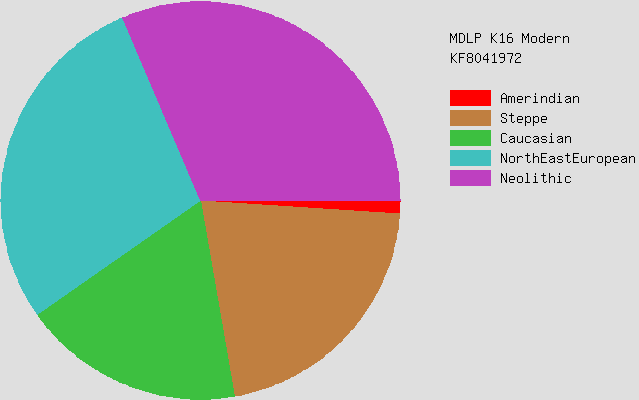
Using the MDLP K16 Modern calculator I got the following admixture,Admixture ResultsThis seems right to me. The family is made up of equal proportions of the first farmers who entered Europe during the Neolithic (both my Y-DNA and mtDNA heritage are from this early farmer population) and of the Paleolithic hunter-gatherers who they met there. Smaller proportions are from the Bronze Age invaders from the Steppes of Russia and the Paleolithic hunter-gatherers that lived south of them in the Caucasus. Apparently there was an American Indian in my family's background as well. The Offerman family claimed this, though I've found no documentary evidence to support the contention. However, percentages this small don't mean much. However, this Amerindian may also be a trace of Ancient Northern Eurasian (ANE), a central Asian strain found in both Germans and native Americans.
30.86% Neolithic (Neolithic Anatolian Farmer (NAF), ancestor of Early European Farmer (EEF))
28.27% North East European (Western Hunter Gatherer (WHG))
21.09% Steppe (European Bronze Age Pastoralists, Yamnaya)
18.16% Caucasian (Caucasus Hunter Gatherer (CHG))
1.09% Amerindian [!!]
0.35% East African (Diluted component derived from ancient Ethiopia/Horn of Africa)
0.18% Ancestor (Archaic component, Khoisan)The following confuses me because it is less German than I would have thought. Perhaps it just reflects how confused the ethnic background may be for someone whose family has lived in the multi-ethnic America for over 300 years. A writer makes a similar point,
"The Oracle analysis looks at what a modern person from a given region looks like and then compares your results with those. For people with relatively low admixture, this works really well and can give you a good idea of what your ancestry might look like. If you're more admixed, though, then the results you see will represent the relative midpoint between your ancestries." - from "Understanding GEDmatch Admixture Tests" by M. P. BrittIn further thought, a lot, perhaps the majority, of my mother's German heritage is from Holstein, in northern Germany. This is the same region that supplied the Angles and Saxons who invaded Britain circa 400 AD. Perhaps the test, while seeing the evidence of Holstein related autosomes, matches my results to early Anglo-Saxons of Britain who share the same heritage. This also makes sense since I imagine there are more early English remains than German that have been tested.Oracle Single Population Sharing (Population/Distance)The problem with the below is not knowing what specific reference is being compared.
1 French (WestFrance) 3.82
2 Scottish (Borders) 4.05
3 English (Kent) 4.05
4 Shetlandic (Shetland_Islands) 4.05
5 Scottish (Dumfries_Galloway) 4.08
6 Scottish (Highlands) 4.22
7 Irish (Connacht) 4.31
8 Scottish (Fife) 4.48
9 Irish (Ulster) 4.72
10 Scottish (Grampian) 4.75
11 Dutch (Netherlands) 4.81
12 English (Cornwall) 4.85
13 Welsh (Wales) 5.01
14 English (England) 5.04
15 Irish (Munster) 5.06
16 Irish (Leinster) 5.08
17 German (Germany) 5.11
18 Irish (Cork_Kerry) 5.3
19 German_Lipsian (Saxony) 5.57
20 Swede (Sweden) 5.77Oracle Mixed Mode Population Sharing (Primary/Secondary/Distance)
1 76% Pole (EastPoland) + 24% Spanish (Pais_Vasco) @ 2.2
2 80.8% Pole (EastPoland) + 19.2% Basque (Spain) @ 2.21
3 75.9% Sorb (Lusatia) + 24.1% French (SouthFrance) @ 2.22
4 76.5% Sorb (Lusatia) + 23.5% Spanish (Pais_Vasco) @ 2.24
5 81.1% Sorb (Lusatia) + 18.9% Basque (France) @ 2.31
6 75.6% Pole (EastPoland) + 24.4% French (SouthFrance) @ 2.35
7 71.7% French (France) + 28.3% Latvian (Latvia) @ 2.42
8 62.7% French (France) + 37.3% Belarusian (Zhytkavichy_Homel) @ 2.43
9 72.3% French (France) + 27.7% Lithuanian (Lithuania) @ 2.43
10 56.2% German (Germany) + 43.8% Norwegian (Norwegia) @ 2.55
11 75.9% Slovak (Slovakia) + 24.1% Spanish (Pais_Vasco) @ 2.6
12 80.6% Slovak (Slovakia) + 19.4% Basque (France) @ 2.63
13 72.7% French (France) + 27.3% Latvian_Dobele (Dobele) @ 2.65
14 71.2% Ukrainian (Ukraine) + 28.8% Spanish (Pais_Vasco) @ 2.65
15 59.5% German (Germany) + 40.5% Icelandic (Iceland) @ 2.67
16 73.2% French (France) + 26.8% Estonian (Estonia) @ 2.69
17 76.2% English (Kent) + 23.8% Hungarian (Budapest) @ 2.72
18 55.6% French (France) + 44.4% Sorb (Lusatia) @ 2.72
19 70.7% Ukrainian (Ukraine) + 29.3% French (SouthFrance) @ 2.73
20 86.7% Swede (Sweden) + 13.3% Sardinian (Sardinia) @ 2.75
Using the puntDNAL K12 Ancient calculator, which compares my sample with ancient-DNA, I got,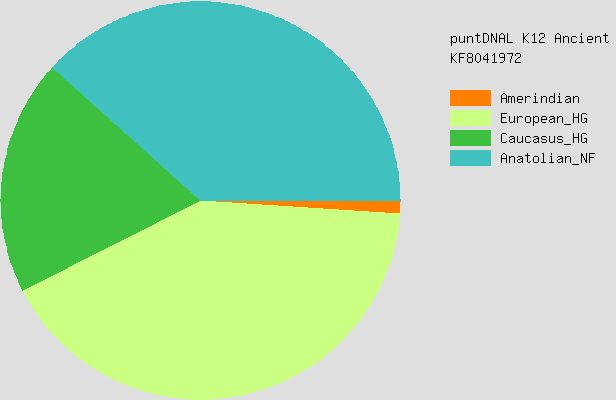 Admixture Results
Admixture Results
41.32% European HG (Western, Eastern and Scandanavian HG)
36.53% Anatolian NF
19.18% Caucasus HG
1.2% Amerindian
0.77% Beringian
0.45% Sub-Saharan
0.2% South African HG
Oracle Single Population Sharing (Population/Distance)
1 Halberstadt_LBA_I0099 4.74 (Lusatian Culture, Urnfield)
2 Unetice_EBA_I0117 4.9
3 Alberstedt_LN_I0118 5.56 (Corded Ware or Bell Beaker)
4 Nordic_LN_SG_RISE97 6.46
5 Bell_Beaker_Germany_I1549 7.43
6 BenzigerodeHeimburg_LN_I0059 7.49
7 Bell_Beaker_Czech_RISE569 10.81
8 Vatya_SG_RISE479 11.22
9 Hungary_BA_I1502 12.1
10 Potapovka_I0419 12.43
11 Corded_Ware_Estonia_RISE00 13.95
12 BattleAxe_Sweden_SG_RISE94 14.02
13 Srubnaya_I0430 14.98
14 Srubnaya_I0232 16.92
15 Corded_Ware_Germany_I0103 17.18
16 Sintashta_MBA_RISE395 18.61
17 Sintashta_MBA_RISE_386 18.75
18 Corded_Ware_Germany_I0104 19.37
19 Andronovo_SG_RISE505 19.92
20 Scythian_IA_I0247 29.14
Oracle Mixed Mode Population Sharing (Primary/Secondary/Distance) ... Central Europe + Neolithic Farmer
1 91.2% Bell_Beaker_Germany_I1549 + 8.8% Anatolian Neolithic_I0745 @ 2.17
2 91.1% Bell_Beaker_Germany_I1549 + 8.9% Anatolian Neolithic_I0746 @ 2.21
3 89.2% Halberstadt_LBA_I0099 + 10.8% Iberia_Chalcolithic_I0300 @ 2.24
4 88.8% Unetice_EBA_I0117 + 11.2% Iberia_Chalcolithic_I0300 @ 2.29
5 88.4% Halberstadt_LBA_I0099 + 11.6% Iberia_M_ I0406 @ 2.39
6 88.5% Unetice_EBA_I0117 + 11.5% Epserstedt_MN_I0172 @ 2.4
7 88.9% Halberstadt_LBA_I0099 + 11.1% Epserstedt_MN_I0172 @ 2.41
8 89.7% Unetice_EBA_I0117 + 10.3% Remedello_BA_SG_RISE489 @ 2.42
9 94.5% Unetice_EBA_I0117 + 5.5% Anatolian Neolithic_I0746 @ 2.43
10 90.1% Halberstadt_LBA_I0099 + 9.9% Remedello_BA_SG_RISE489 @ 2.44
11 94.6% Unetice_EBA_I0117 + 5.4% Anatolian Neolithic_I0745 @ 2.45
12 88.1% Unetice_EBA_I0117 + 11.9% Iberia_M_ I0406 @ 2.45
13 94.8% Halberstadt_LBA_I0099 + 5.2% Anatolian Neolithic_I0745 @ 2.54
14 94.8% Halberstadt_LBA_I0099 + 5.2% Anatolian Neolithic_I0746 @ 2.54
15 88.9% Halberstadt_LBA_I0099 + 11.1% Baalberge_MN_I0560 @ 2.65
16 88.6% Unetice_EBA_I0117 + 11.4% Baalberge_MN_I0560 @ 2.7
17 91.4% BenzigerodeHeimburg_LN_I0059 + 8.6% Anatolian Neolithic_I0745 @ 2.87
18 91.4% BenzigerodeHeimburg_LN_I0059 + 8.6% Anatolian Neolithic_I0746 @ 2.94
19 90.5% Unetice_EBA_I0117 + 9.5% Iberia_EN_I0412 @ 2.95
20 89.6% Unetice_EBA_I0117 + 10.4% Iceman_MN_SG @ 2.96
Using the Eurogene K36 calculator, and re-ordering per the schema of Maciamo, I got,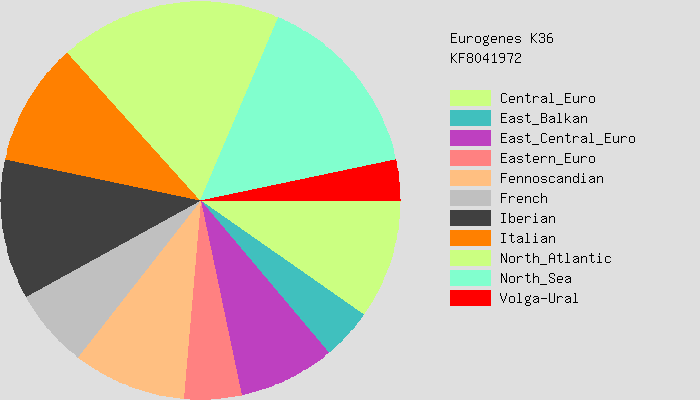 Admixture Results
Admixture Results
Mesolithic hunter-gatherer components (54.91%):*
17.88% North_Atlantic
15.38% North_Sea
9.16% Fennoscandian
7.75% East_Central_Euro
4.74% Eastern_Euro
* Found in WHG, SHG & EHG
Neolithic farmer componens (26.06%):*
11.24% Iberian
10.17% Italian
4.15% East_Balkan
0.50% West_Med
* In Neolithic Hungary (Alfold LBK) and Germany (LBK), the main components were Iberian, Italian and West_Med. In Funnelbeaker Sweden, had high levels of Iberian, East_Balkan and West_Med, but no Italian at all.
Bronze Age steppe components:
All the same components as in Mesolithic Europeans were found, but also:*
1.40% Volga-Ural
* That is, Yamnaya is made up of approximately 60% EHG/SHG and 40% Caucasus.
Other components:
0.78% Amerindian
9.67% Central_Euro*
*Absent from Mesolithic Spain, Neolithic Germany and Afanasievo and was only at 1% in Yamna. It seems to peak in Central Europe and Scandinavia, but it isn't a Steppe component. It seems to go hand in hand with the French component and could both be associated with Y-haplogroup I1, which was only found in central Europe and Scandinavia before the Germanic migrations in the Iron Age.
0.69% East_African
6.49% French*
*Absent in Yamna, but is found at low frequency (2.5%) in the contemporaneous Afanasievo culture in the Altai (which is otherwise almost identical to Yamna autosomally), at higher frequency in Sintashta (10%) and Corded Ware Denmark (11.5%), and even higher in Corded Ware Poland (26%) and in Nordic Bronze Age Denmark (31.5%), but then sharply decreases in Iron Age Sweden (6%).
The latter calculator does not provide an Oracle analysis, so I ran my Eurogenes K36 results through a Map Creator. The higher the number the closer the matching. So, yeah, we're very much northwestern Europe in background.
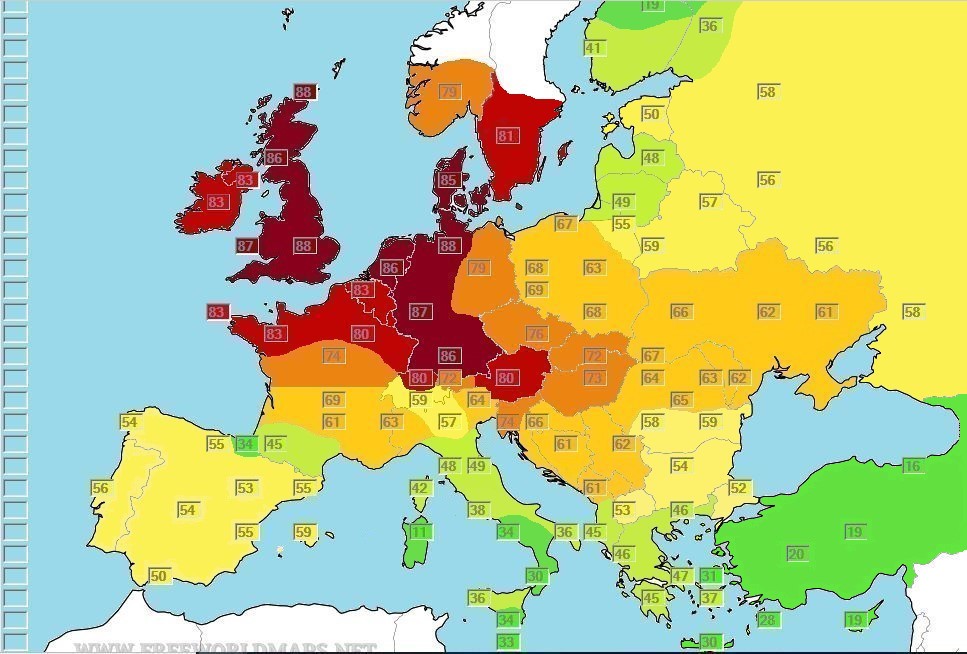
I did find an Oracle for the Eurogenes K36 calculator on the yourDNAportal site. The results,
Closest Population Distances
Population / Distance
SZ42_Longobard 0.8287684 - [Longobard/Lombard may reflect my mother's north German origins]
EMA_Hinxton5_Anglosaxon 0.9829161 - [this and the British entries below may reflect my father's English origins]
I1767_Beaker_Britain 0.9952447
SZ23_Longobard 1.0872971
CL83_Celto-Longobard 1.1031967
IA_Britain_York_6DRIF22 1.1094287
SZ3_Longobard 1.1925749
I1767_EarlyBronze_Age_Briton 1.2027198
Population / Value
SZ42_Longobard 16.8
IA_Britain_York_6DRIF22 12.4
I1767_Beaker_Britain 10.6
Baiuvarii_Germanic_STR_355 9.6
I1767_EarlyBronze_Age_Briton 4.2
IA_Celtic_Britain_Hinxton1 2.8
SZ3_Longobard 2.6
Baiuvarii_Germanic_ALH_10 2.2
SZ30_Celtic 2.2
Baiuvarii_Germanic_STR_393 2
CL83_Celto-Longobard 2
IA_Hinxton4_Celtic_Roman 2
BA_Unetice_Poland_RISE150 1.6
CL63_Alpine 1.6
Baiuvarii_Germanic_STR_486 1.4
IA_Wielbark_Kow_55_PL 1.4
SZ5_Pannonian 1.4
SZ7_Longobard 1.4
BA_Hungary_BR2 1
LNBA_Urnfield_Germany_I0099 1
Baiuvarii_Germanic_ALH_1 0.8
CL23_north-Italian 0.8
CWC_Sweden_RISE97 0.8
EMA_Hinxton5_Anglosaxon 0.8
IA_Wielbark_Kow_25_PL 0.8
SZ2_Longobard 0.8
Scythian009_Ukraine 0.8
Visigoth_I12163 0.8
AV1_Hungary_Szolad 0.6
BA_Hungary_RISE371 0.6
BA_Sintashta_RISE395 0.6
BA_Srubnaya_I0235 0.6
BA_Srubnaya_I0358 0.6
BA_Unetice_Germany__I0115 0.6
EMA_north-Italian_NW_54 0.6
IA_Britain_York_3DRIF16 0.6
SZ18_Pannonian 0.6
BA_Srubnaya_I0359 0.4
BA_Unetice_Germany_I0164 0.4
Baiuvarii_Germanic_AED_106 0.4
Baiuvarii_Germanic_STR_360 0.4
DA112_Hallstatt-Bylany_800BC 0.4
DA119_Germanic_chieftain_Poprad 0.4
EMA_Balkan_AED_125 0.4
I2462_Bronze_Age_England_Kent 0.4
SZ13_Longobard 0.4
Amerindian_Kennewick 0.2
BA_I9006_Mycenean 0.2
BA_I9041_Mycenaean 0.2
BA_Srubnaya_I0423 0.2
Baiuvarii_Germanic_STR_266 0.2
Bell_Beaker_Germany_I0171 0.2
CL102_Frankish 0.2
CL57_north-Italian0.2
CL84_Longobard 0.2
CL94_Iberian 0.2
DA191_Hungary_Scythian 0.2
EMA_Hinxton2_Anglosaxon 0.2
I5385_Scotland_Bell_Beaker 0.2
IA_Wielbark_Kow_22_PL 0.2
MA2196_Ottoman_14001600 0.2
MA2197_Anatolia_IA 0.2
Mesolithic_Sweden_Ajvide59 0.2
N_Sweden_Gokhem5 0.2
SZ23_Longobard 0.2
SZ24_Longobard 0.2
SZ4_Longobard 0.2
i3759_Celtiberian_IA 0.2
Using their K47 calculator I got,
Admixture ResultsNo EEF!? There is no Oracle for this calculator.
18.55% North Sea Germanic (UK, Ireland, Scandanavia)
18.51% Celtic
9.16% East Iberian
8.69% East European
8.03% Scando Germanic
7.05% West Finnic
6.16% Central Mediterranean
5.36% Baltic (Estonia, Latvia, Lithuania)
3.96% North Iberian
2.98% West Mediterranean
2.98% Pamirian
2.86% Paleo Balkan
1.64% Volgan
1.56% East Mediterranean (Cyprus, Turkey, Syria, Lebanon, Israel)
0.66% East African HG
0.38% Iranian
0.15% Amazonian
Using the Ancient Near East K13 calculator I got,
Admixture ResultsLittle or no Steppe/Yamnaya. With Oracle,
40.52% CHG-EEF (Caucasus HG, Early European Farmer)
17.62% SHG-WHG (Scandanavian-Western HG)
15.50% EHG (Eastern HG)
14.21% Anatolia Neolithic
4.93% Iran-Neolithic
4.48% Natufian
2.19% Ancestral-Indian
0.45% Sub-Saharan
0.10% Karitiana (Indigenous people of Brazil)
Closest population distances
Population / Distance
Hungarian 0.7497746
French 0.7532914
Croatian 0.8224767
Romanian 0.9386362
Scottish 0.9583961
English 0.9861278
Ukrainian 0.9993758
Czech 1.00848
Population / Value
French 49.2
Ukrainian 6.4
Hungarian 6
Scottish 5.8
Lithuanian 5.4
Europe_LNBA 3.8
Estonian 2.4
Finnish 2.2
Bulgarian 2
Czech 1.8
Russian 1.2
Greek 1
Steppe_MLBA 1
SHG 0.8
Turkish_Trabzon 0.8
Anatolia_ChL 0.6
Anatolia_N 0.6
Armenia_MLBA 0.6
Bichon 0.6
Cypriot 0.6
Jew_Moroccan 0.6
Turkish_Kayseri 0.6
Egyptian 0.4
Saudi 0.4
Steppe_IA 0.4
Turkish_Istanbul 0.4
Adygei 0.2
Armenia_ChL 0.2
Assyrian 0.2
Balochi 0.2
EHG 0.2
Esan 0.2
Europe_EN 0.2
Hazara 0.2
Iran_recent 0.2
Jew_Iranian 0.2
Jew_Libyan 0.2
Kurd_C 0.2
Kusunda 0.2
Lezgin 0.2
MA1 0.2
Nogai 0.2
Palestinian 0.2
Steppe_EMBA 0.2
Tajik 0.2
Turkish_Adana 0.2
Turkish_Balekesir 0.2
WHG 0.2
There is a new calculator at vahaduo.genetics.ovh. It uses your GEDMatch results and compares them to different DNA source material . The following used my results, "Steve," from the Dodecad K12b updated calculator. The following makes perfect sense to me with a close relationship to the Germans & Dutch, a heavy admixture of English, and a salting of Irish and Scot.
Distance to: SteveThe following results were obtained using the same Vahaduo calculator as above, but with a new source database of 557 ancient DNA samples created by Jovialis & Duarte of eupedia.com. Do not make the mistake of assuming that a large number of hits for one ethnic group, i.e. Longobard, means a close association. It just so happens that a number of Longobard remains have been recovered and tested. It is only the distance that is relevant. A note: "The vast majority of the coordinates included so far refer to samples obtained in Italy, Iberia, Central Europe and Balkans. The current entry coordinates do not favor people from northern and northwestern Europe. Many coordinates of samples from that area would be needed in the source dada entry and these coordinates have not yet been obtained." - from Duarte. Also, "MTA considers that distances up to 10 are from individuals who are their ancestors, from 11 to 20 of individuals who are part of your ancestry, and from 21 to 30 of individuals who are possibly related to your ancestry. Maciamo Hey considers distances of 7 as a strong indication of ancestry."
5.01560565 Mixed_Germanic
5.13617562 Dutch
5.62194806 German
7.64894110 CEU30
7.87254724 Kent
7.89077309 English
8.52058097 British_Isles
10.58320840 Orkney
10.62206665 British
10.63664891 Argyll
10.64538867 Cornwall
10.94807289 Orcadian
10.95978558 Irish
11.79632994 French
11.94815048 Norwegian
12.36108005 French
13.56806176 Swedish
13.93772937 Hungarians
15.86642367 Croat
17.44008028 Bosnian
19.26323687 Italy_Aosta_Valley
21.21688856 Italy_Trentino
22.61061283 Swiss_Italian
22.85724734 Italy_FriuliVG
24.30674186 Macedonian
Distance to: Steve
2.35955504 R31_Late_Antiquity_Mausole_di_Augusto [Germanic pilgrim]
3.46333654 R1286_Medieval_Era_Cancelleria [Germanic pilgrim]
3.60736746 SZ15
3.77576482 SZ7
4.22257031 CL84
4.37109826 SZ12
4.62792610 SZ24
4.64708511 BronzeAgeOuterHebrides_I2655 [c1200 BC, megalithic British DNA: I2a, but Beaker-like]
4.71195289 SZ38
4.75172600 SZ11
4.86805916 SZ22
4.98527833 I8212_NE_Iberia_Greek_Empuries1_atypical [Greek colony northern Catalonia c300BC, Mycenaean-like]
5.01270386 BronzeAgeUnetice_I0047 [Halberstadt-Sonntagsfeld, Germany, 1815-1789 BC]
5.23058314 CL83
5.32573939 SZ42
5.45594172 NorthAlpineSouthDutch_AITI_50 [Lech Valley, Austria, 1815-1789 BC, South Dutch affinity, see Celtic Origins page for more]
5.53249492 SZ30
5.55252195 CL92
5.71852254 SZ23
5.75477193 SZ13
5.83136348 CL87
5.88554161 NorthAlpineSouthDutch_AITI_2 [Lech Valley, Austria, 1815-1789 BC, South Durch affinity]
5.89702467 SZ4
6.10280263 CL145
6.20954910 CL146
6.25362295 CL93
6.44491272 CrusaderKnightCelto-GermanicLebanonCrusaderSI47 [South Dutch / Swiss German affinity]
6.68184855 SZ14
6.92434834 R1288_Medieval_Era_Cancelleria [mixed German-French pilgrim]
7.12070923 BellBeakerSouthernFrance_I3874
7.57825178 CrusaderKnightCelto-GermanicLebanonCrusaderSI39 [similar to S147, more west German]
8.01349487 IronAgeHinxton5_Anglo-Saxon_ERS389799
8.04563857 SZ3
8.05190040 CL151
8.15597940 IronAgeHinxton1_Celt_ERS389795
8.38453934 SZ8
8.42832724 SZ9
8.57887522 SZ41
8.65687588 R62_Medieval_Era_Villa_Magna [south Italy, French-Belgian affinity]
8.82216527 SZ25
8.88892007 CL97
8.91423581 SZ16
9.22968580 R1219_Medieval_Era_Cancelleria [Austrian pilgrim]
9.28500942 VisigothGermanicGirona_I12163 [Visigoth with significant German affinity]
9.53717463 IronAgeHinxton2_Anglo-Saxon_ERS389796
9.60063019 VisigothFrankishGirona_I12032 [Visigoth with significant Celtic admixture]
9.68680546 I8206_NE_Iberia_Hel_Empuries1
9.81795294 CuevadelaPalomaSpain_I3243
10.03495391 NorthAlpineBronzeAgeFrench_AITI_78 [Lech Valley, Austria, 1815-1789 BC, French affinity]
10.16478726 R106_Late_Antiquity_Crypta_Balbi
10.34075916 ANI163_Varna_Outlier
10.38155576 JK2065_Levanluhta_B_Isokyro_Finland_300–800_CE
10.44236563 SZ2
11.24027135 AlemannicBavariaBIM_33
12.55419452 SZ5
13.10780302 SZ6
13.33495407 I4110_Ukraine_Eneolithic
13.36987285 CL63
13.42328574 R1220_Medieval_Era_Cancelleria
13.74641772 CeltiberianMixTribeNorthernSpain_I3238
13.96846090 I2181_Balkans_Chalcolithic_outlier
14.20491816 CL102
14.55036426 R116_Imperial_Era_Via_Paisiello_Necropolis
14.83195537 SZ18
15.02241991 CL53
15.04363320 BronzeAgeEngland_I2462
15.05362747 R108_Late_Antiquity_Crypta_Balbi
15.23390298 ElMiron_Magdalenian_Spain
15.31273000 NorthAlpineBronzeAgeFrench_AITI_119 [Lech Valley, Austria, 1815-1789 BC, French affinity]
15.93313528 SZ45
16.09910867 CL47
16.30564626 CL57
16.44150845 BasqueCarolingian_I3777
16.57140006 R1224_Medieval_Era_Cancelleria
17.13827879 NorthAlpineBronzeAgeFrench_AITI_43 [Lech Valley, Austria, 1815-1789 BC, French affinity]
17.23203412 Falkenstein_Mesolithic_Germany
17.71326057 NorthAlpineBronzeAgeSpanishGalicia_AITI_72 [Lech Valley, Austria, 1815-1789 BC, Spanish-Galicia affinity]
17.81350892 NorthAlpineBronzeAgeFrench_AITI_120 [Lech Valley, Austria, 1815-1789 BC, French affinity]
17.98983324 R1221_Medieval_Era_Cancelleria
17.99710254 I8202_NE_Iberia_RomP_Empuries1
18.01940066 GironaSantJuliadeRamis_I10851
18.22255745 SZ27
18.23840728 VasconesTribeVasconia_I3758
18.78715253 CL94
18.85916488 Villabruna
19.28914980 I4175_Vucedol
19.43477039 R61_Medieval_Era_Villa_Magna
19.61410207 I8209_NE_Iberia_Greek_Empuries1
19.61410207 VasconicTribe_I8209
19.75882082 Roman-SoldierFN_2
A recent paper addresses Bell Beaker and Early Bronze Age burials in the Lech valley of the Tyrol.
"The article states that 17 of the samples were R1b-P312/S116*, while 10 more appeared to be R1 as well, but not derived beyond L11. Of the other Y-haplogroups identified, there were only one member of haplogroup I and two of G2. I have always maintained that haplogroups I2a2b-L38 and G2a-Z1816 [the 'grandfather' of Z726] were found among Hallstatt/La Tene Celts, so I wouldn't be surprised if a retesting of these skeletons with better quality DNA yielded these clades." - from Maciamoand,
"The burials of the Lech Valley range among the richest in the entire Northern Alpine EBA [Early Bronze Age] with only a very small percentage of individuals buried without grave goods. The accumulation of economic wealth in the Lech Valley EBA communities was most probably based on the surplus production of agricultural goods due to the very fertile loess soil south of the city of Augsburg . . . HUGO_169Sk1 and UNTA58_68Sk1, both dated to the BBC, fall on the Y clade G2, which was among the most frequent in Europe in the preceding Neolithic period, and was likely carried there by the expansion of early farmers out of Anatolia." - from "Kinship-based social inequality in Bronze Age Europe" by Mittnik, et al, 2019A similiarity map for some of the youngest of Lech valley Early Bronze Age samples is shown below. They are dated to 1815-1789 BC. Note the hot spot in the Seine river valley of France.
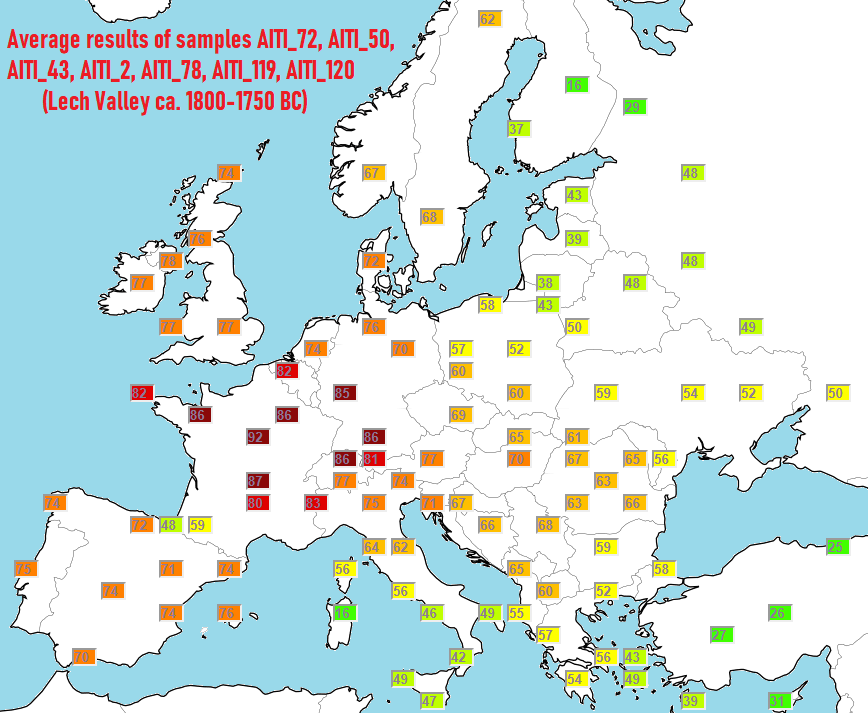
The below is also interesting. It is from MyTrueAncestry and tries to show the relationship between your DNA and that of ancient peoples and empires. Those closest to me are . . .
Viking Norwegian + Frank (3.703)This makes sense. My mother's family is wholly German, predominantly from Holstein, which is in Old Saxony. The Saxons, of course, also settled in England in the 5th century.
Saxon + Frank (4.152)
Visigoth + Saxon (4.261)
Viking Norwegian + Visigoth (4.614)
Viking Norwegian + Saxon (4.883)
Saxon (5.171)
Frank (6.0)
Viking Norwegian (7.252)
Viking Danish (7.479)
Visigoth (7.524)
"These earliest known tribal Saxons inhabited "Northern Albingia", a region bordering the northern bank of the mouth of River Elbe in what is now Western Holstein. As land became scarce, the Saxon population began to expand southward where it absorbed indigenous populations such as Cherusci, Chamavi and Chatti, and remaining portions of the Langobardi (Lombards) and Suebi. This broader domain is called "Old Saxony". The Chauci, according to Tacitus, also lived in the general area later known as Old Saxony and were highly respected among Germanic tribes. He describes them as peaceful, calm, and levelheaded. At some point they may have merged with, or were perhaps synonymous to, the Saxons . . . After the fall of the Western Roman Empire in the 5th century the Old Saxons who remained in Germania were loosely associated with the Merovingian kingdom of Franks . . ." - from Wikipedia
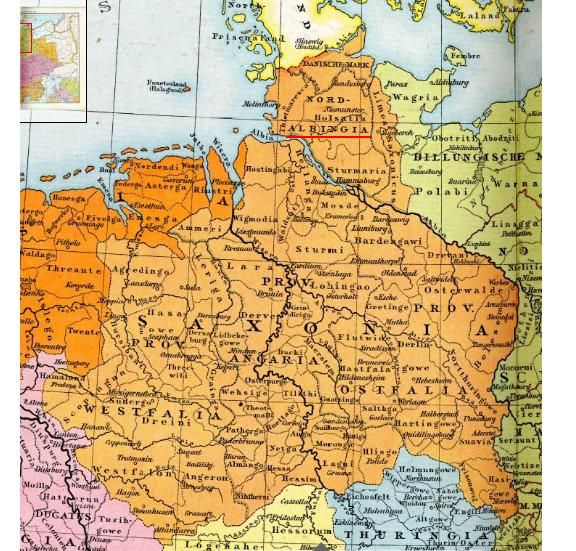
| The Saxons
|
| The Franks
|
| Danish Vikings
Angul and Danum were sons of the all seeing god Heimdall. Angul became father of the Angles who conquered the Frisii and the Roman province of Britannia, Danum would become the father of the Dani in Scania. Soon everyone would know this as the land of the Danes or Denmark (named after its marshland border with the Franks). Masters of the sea, they would raid small villages on the Frankish coast to start with, but as money and slaves flowed in, they became more ambitious. Danish Vikings eventually became conquerors and settled the Danelaw in Britain. This is where the laws of the Danes held sway and dominated those of the Anglo-Saxons. In the 10th century the kingdom of Denmark coalesced in Jutland under King Gorm the Old. His son Harald Bluetooth conquered Norway, unified Denmark, and Christianized the Danes. These accomplishments are inscribed in runic on a huge gravestone at Jelling. His son Sweyn Forkbeard raided England anually and was accepted as king of that country. His son Cnut the Great reconquered Norway and forged an Anglo-Danish kingdom that lasted until his death in 1035.  |
My closest Archaeogenetic matches (to individual ancient remains), ordered by genetic distance, are:
1. Saxon Hinxton (720 AD) (5.171) [about 50 miles north of London]- Shohola is a creek in Pike county, in eastern Pennsylvania. The remains of a European colonist were found at Shohola creek, Indian Cabin Ridge, Pennsylvania, dated to 1634-1662 AD. This may be a Dutch ancestor of Thomas Hesom & Catarina Kleyn's family. The remains were typed as I1a-Z73 and U4c1a - from "Ancient Human Parallel Lineages within North America Contributed to a Coastal Expansion" by C.L. Scheib, et al. However, when I compare my DNA with this sample I get no shared DNA segments.
2. Colonial American Pennsylvania (1700 AD) (5.276) [Shohola creek]
3. Medieval Denmark (1250 AD) (5.779)
4. Frankish/Hungary (590 AD) (6.0)
5. Bell Beaker Scotland (6.325)
6. Alemannic Bavaria (500 AD) (6.426) [southwestern Germany]
7. Viking Saxon Iceland (6.635)
8. Medieval Norway Sankt Nikolai B (1349 AD) (7.252)
9. Post Viking Denmark Odense (1250 AD) (7.479)
10. Anglo Saxon (780 AD) (7.49)
11. Visigoth Germanic Girona (550 AD) (7.524)
12. Late Medieval Gotlander (1600 AD) (7.605)
13. Corded Ware Denmark (2450 BC) (7.782)
14. Nordic Lombard (590 AD) (7.801)
15. Bronze Age Celt England (1000 BC) (7.814)
16. 1815-1789 BC Thames (1800 BC) (7.883)
17. Medieval Netherlands Plague II (1360 AD) (8.002)
18. Bell Beaker Southern France (2050 BC) (8.005)
19. Young Merovingian Noble NS6 (605 AD) (8.0224) - mtDNA : H65a / Y-DNA : R1b1a2a1a1c2b2b
20. Merovingian Noble NS1 (605 AD) (8.0657) - mtDNA : K1a / Y-DNA : R1b1a2a1a1c2b2b1a1
21. Bell Beaker Germany (2500 BC) (8.115)
22. Bell Beaker Scotland (2145 BC) (8.119)
23. Nordic Lombard (590 AD) (8.27)
24. Medieval Norway Sankt Nicolai (1349 AD) (8.336
25. Bell Beaker England (2100 BC) (8.356)
26. Nordic Lombard / Winnili (590 AD) (8.363)
27. Lugii Tribe Iron Age Maslomecz (300 AD) (8.39)
28. Saxon Germanic Empuries (275 BC) (8.415)
29. Nordic Lombard (590 AD) (8.44)
30. Visigoth Frankish Girona (550 AD) (8.467)
31. Nordic Lombard (670 AD) (8.495)
32. Frankish / Hungary (590 AD) (8.495)
33. Icelander Late Medieval (1650 AD) (8.536)
34. Nordic Lombard (590 AD) (8.562)
35. Ostrogoth Nordic (520 AD) (8.693)
36. Nordic Lombard (590 AD) (8.722)
37. Bronze Age Orkney Islands (1750 BC) (8.91)
38. Bell Beaker England (2150 BC) (8.926)
39. Scotland Late Bronze Age (900 BC) (8.963)
40. Alemannic Bavaria (450 AD) (9.175)
41. Alemannic Saxon Bavaria (500 AD) (9.236)
42. Viking Sweden (1100 AD) (9.287)
xx. Nordic-Celtic Gladiator York 6DRIF-18 (250 AD) - mtDNA : H1bs / Y-DNA : R1b1a2a1a, Genetic Distance: 9.5951
xx. Merovingian Noble NS12b (605 AD) - mtDNA : X2b4 / Y-DNA : R1b1a2a1a1c2b2b1a1, Genetic Distance: 9.7352
xx. St Marys Coffin Maryland I2097 (1683 AD) - mtDNA : HV0 / Y-DNA : R-S10067, Genetic Distance: 10.331
xx. Celtic Gladiator York 6DRIF-21 (250 AD) - mtDNA : J1c3e2 / Y-DNA : R1b1a2a1a2c2, Genetic Distance: 11.106
xx. Celtic Briton Gladiator York 3DRIF-16 (250 AD) - mtDNA : H6a1a / Y-DNA : R1b1a2a1a1, Genetic Distance: 11.328
xx. Philip Calvert Coffin Maryland 2099 (1683 AD) - mtDNA : T2b / Y-DNA : R-S10067, Genetic Distance: 11.965
xx. Celtic Briton Gladiator York 6DRIF-3 (250 AD) - mtDNA : J1b1a1 / Y-DNA : R1b1a2a1a1, Genetic Distance: 12.378
xx. Merovingian Lord NS9 (605 AD) - mtDNA : X2b4 / Y-DNA : R1b1a2a1a1c2b2b1a1, Genetic Distance: 12.651
xx. Le Mans Revolutionary France LM_306_T (1793 AD) - mtDNA : H46 / Y-DNA : Uncertain, Genetic Distance: 12.749
xx. Celtic Briton Gladiator York 6DRIF-23 (250 AD) - mtDNA : H6a1b2 / Y-DNA : R1b1a2a1a, Genetic Distance: 13.033
xx. Viking High-Ranking Shieldmaiden brk581 (950 AD) - mtDNA : T2b, Genetic Distance: 13.061
xx. Celtic Briton Gladiator York 6DRIF-22 (250 AD) - mtDNA : H / Y-DNA : R1b1a2a1a2b, Genetic Distance: 13.583
xx. Merovingian Noble NS3a (605 AD) - mtDNA : K1a / Y-DNA : R1b1a2a1a1c2b2b1a1, Genetic Distance: 14.564
xx. Le Mans Revolutionary France LM_403_T (1793 AD) - mtDNA : K1c1 / Y-DNA : Uncertain, Genetic Distance: 14.584
The following is the above in map format,
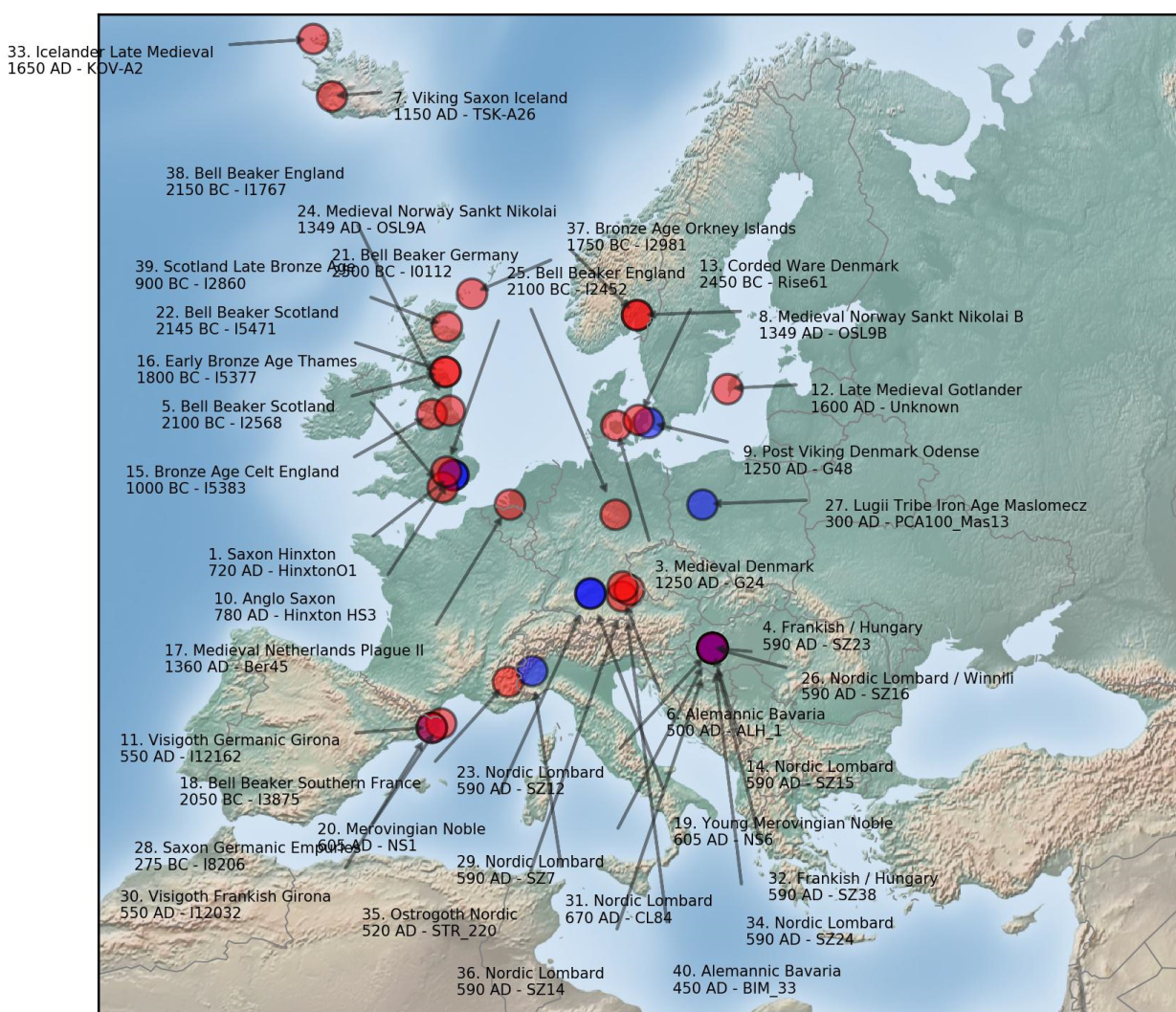
Ancient relatives with whom I share identified DNA segments:
Corded Ware Denmark (2450 BC) [Holstein adjacent], also as Battle Ax Denmark (2650-2300 BC)
- Rise61 [M130094]: mtDNA: J1c4, Y-DNA: R1a1a1, Total cM=49.85, Largest segment=11.98 cM (17 shared. Sample quality: 17) - Your raw DNA is 74% closer than other matching users
Bell Beaker Germany (2500 BC)
- I0112 [M324645]: mtDNA: H13a1a2, Y-DNA: Uncertain, Total cM=30.88, Largest segment=9.24 cM (6 shared. Sample quality: 43) - Your raw DNA is 58% closer than other matching users
Bronze Age Germany (1050 BC), also as HalberstadtLNBA
- I0099 [M313201]: mtDNA: H23 Y-DNA: Uncertain, Total cM=15.91, Largest segment=8.68 cM (3 shared. Sample quality: 43) - Your raw DNA is 43% closer than other matching users
Viking Sweden (935 AD), also as Sigtuna
- gtm021 [NF4759746]: mtDNA: H5a1g1, Total cM=3.25, Largest segment=3.25 cM (1 shared. Sample quality: 28) - Your raw DNA is 39% closer than other matching users
Celtic Gladiator York (250 AD) [northern England]
- 6DRIF-21 [T807839]: mtDNA: J1c3e2, Y-DNA: R1b1a2a1a2c2, Total cM=2.49, Largest segment=2.49 cM (1 shared. Sample quality: 25) - Your raw DNA is 18% closer than other matching users
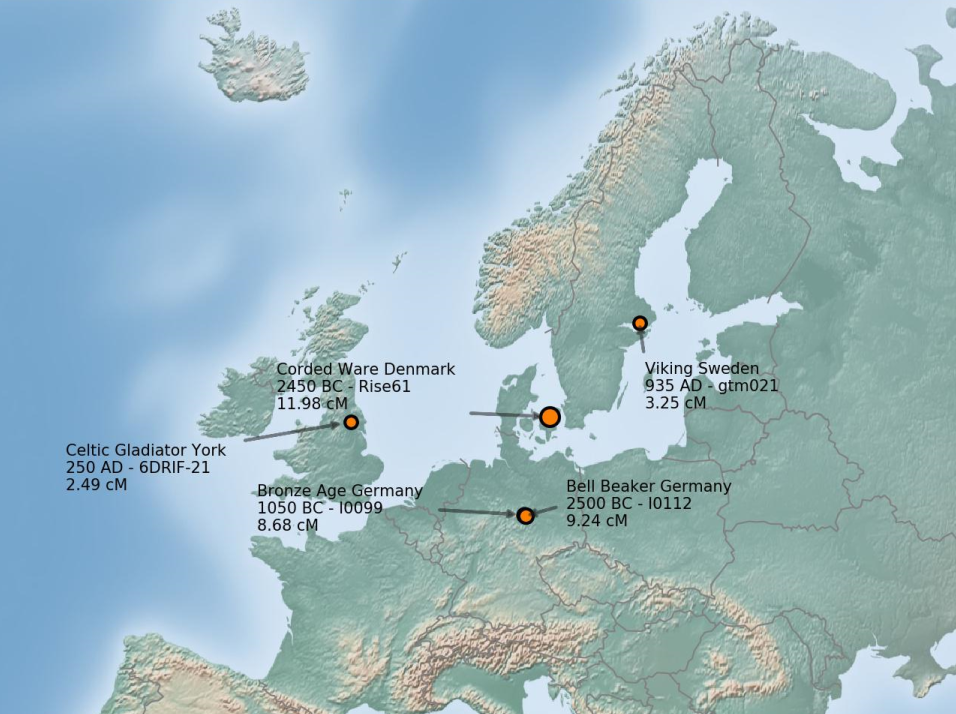
My closest genetic modern populations...
1. Welsh (5.052)Why Welsh I wonder? Dutch makes sense with Kleyn and Busch ancestry of paternal line. Danish and North/West German works with maternal ancestry.
2. North_Dutch (5.655)
3. West_German (6.487)
4. Southwest_English (6.528)
5. Danish (6.764)
6. Flemish (6.835)
7. Southeast_English (6.911)
8. Norwegian (6.965)
Maps of the above:
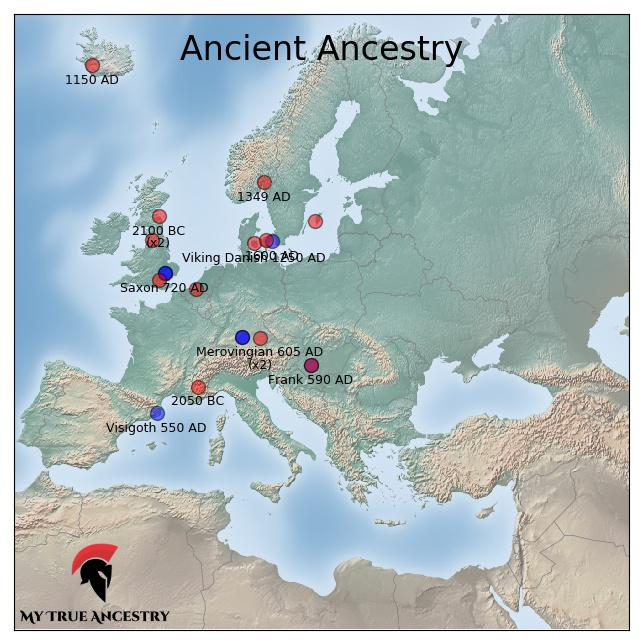
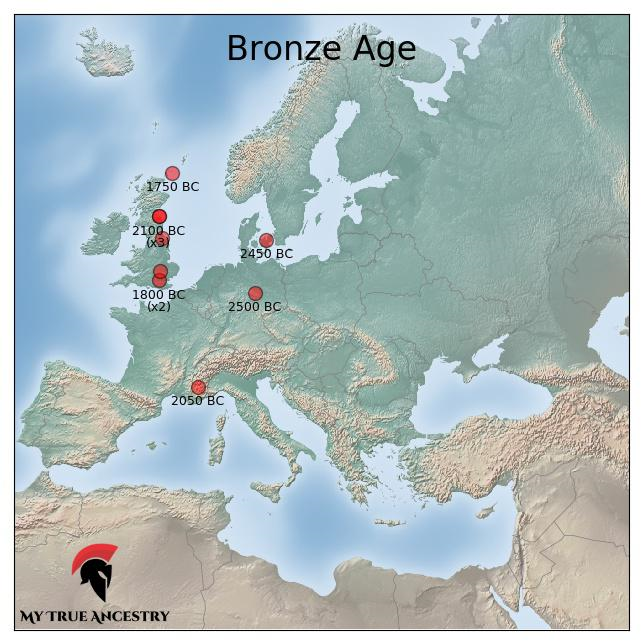
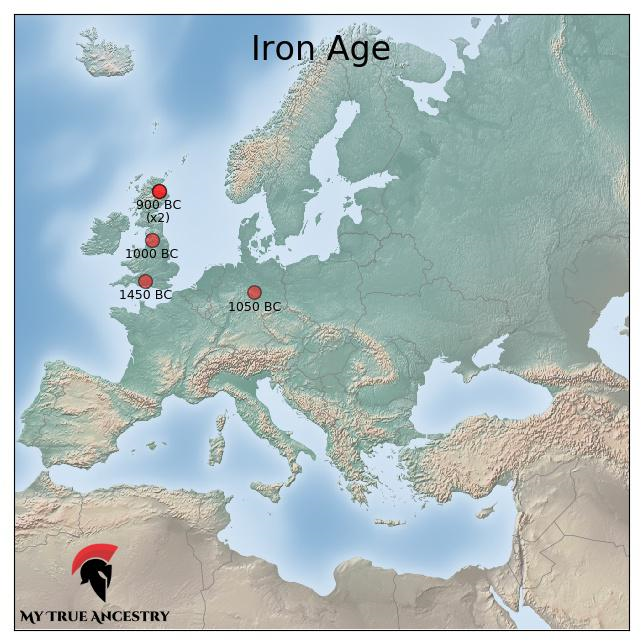
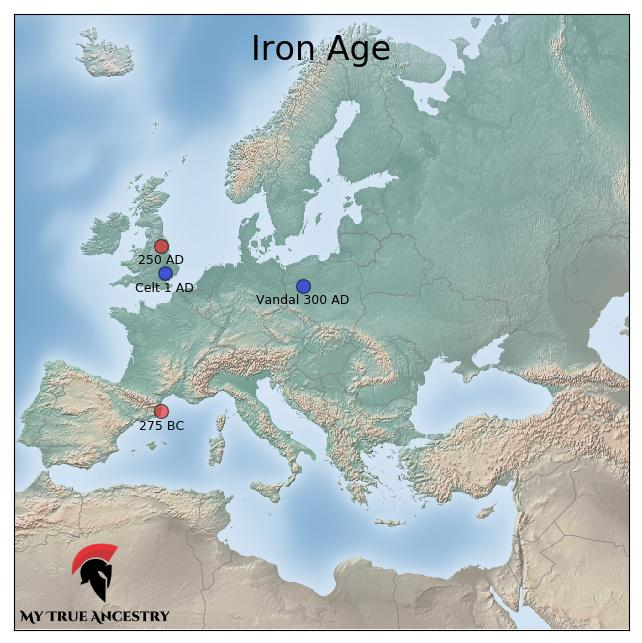
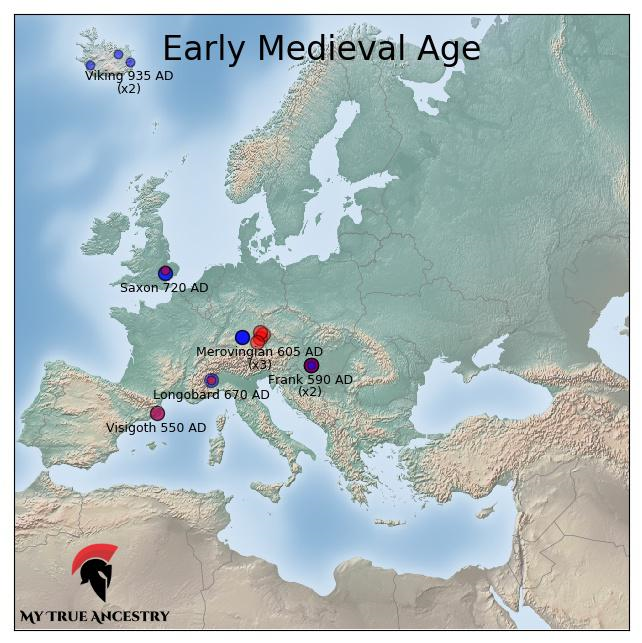
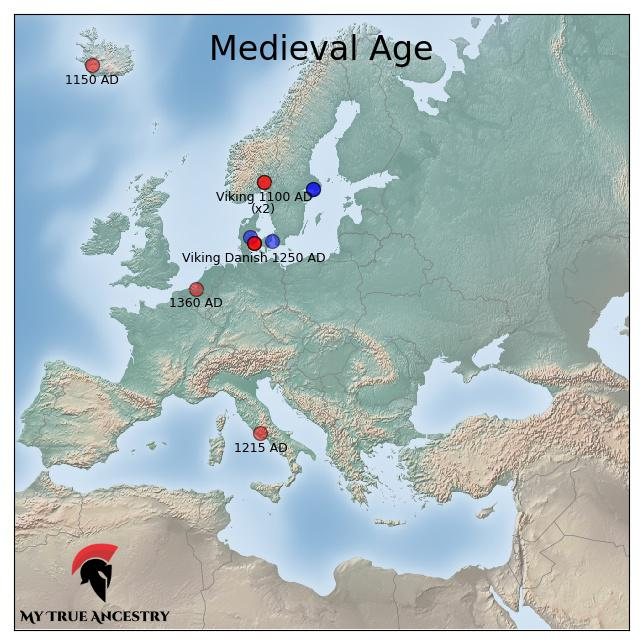
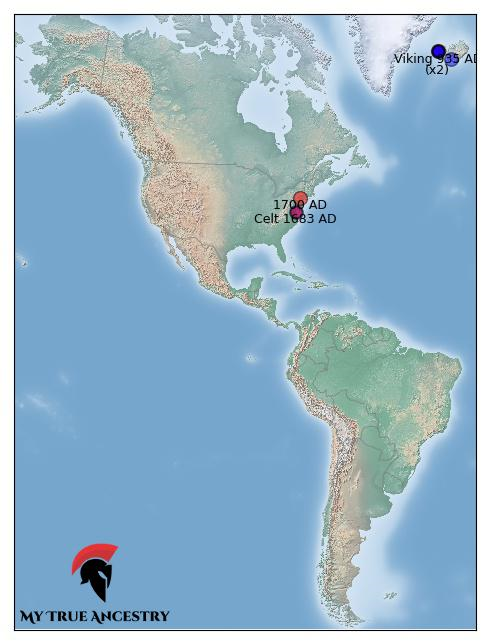
Note that the dots in the map above show where the remains of a body were found. Those remains were tied to a particular culture using archaelogical data. The dot does not necessarily show where that culture was most dominant.
My closest Archaeogenetic matches, in timeline format:

A new feature predicts the Y-DNA Distribution of all ancient male samples that match my autosomal DNA kit. The results are,
64.0% R1bHaplogroup G doesn't register at all! My father's line could be the only G type in my background. To illustrate, if we only go back 10 generations I have 1023 different male lines in my ancestry. 628 of those would have been R1b per this prediction. Haplogroup percentages across Europe:
15.7% R1a
11.2% I2
04.49% I1
01.12% J
01.12% N
01.12% E
01.12% I
33.5% R1bSo we could predict the ordering of the True Ancestry results simply based on this latter listing, barring E3b (now known as E1b1b). The E3b type migrated into Europe from North Africa. It has the highest concentration in Kosovo (over 45%), Albania and Montenegro (both 27%), Bulgaria (23%), Macedonia and Greece (both 21%), Cyprus (20%), Sicily (20%), South Italy (18.5%), Serbia (18%) and Romania (15%), so oriented very much to southeastern Europe. This, combined with R1b, which is predominantly western European, being at 61.4% vice the 33.5% standard, shows how far towards northwestern Europe my Y-DNA results are skewed.
21.0% R1a
9.5% I2
8.5% I1
7.0% E3b
6.5% J2
5.5% N
3.5% G
1.0% T
1.0% J1
1.0% Q
1.5% Others
One of the reasons my wife was interested in this test was because of the uncertainty about her mother's heritage. While her maternal line lived in Ireland as cotters until 1871, Anita's grandmother, Rose Royston, was the daughter of an unidentified man (not her mother's husband) while her grandfather, Rose's husband, was an orphan. The data from Living DNA indicates that Anita's heritage is,
68.3% British Isles
Regions:
- 30.6% Ireland
- 14.4% Southeast England
- 8% Northumbria
- 4.6% Southwest Scotland and Northern Ireland (Scots-Irish)
- 3.8% Devon
- 2.4% East Anglia
- 2.2% South Central England
- 2.2% North Yorkshire
31.7% Europe (North and West)
Regions:
- 31.7% Scandinavia
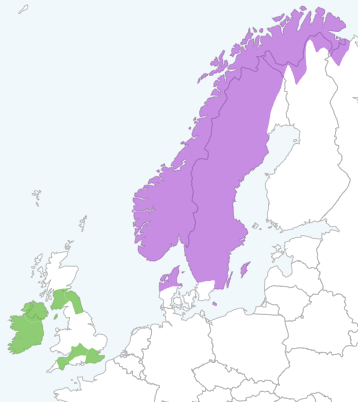
The Scandanavian may reflect the Viking habitation in Ireland and northern England during the Medieval, or the heritage of Anita's grandfather and/or unknown great-grandfather.
I ran these autosomal results through GEDmatch, a third-party open-source personal genomics database, to derive my wife's ethnicity/admixture. The results are both confusing and contradictory (at least at my current level of understanding). By the way, the following tests compare my wife's autosomal results against many populations, including those living thousands of years ago. The results tell me which population she is more like.
Below are the results of three different admixture calculators. The first, MDLP K16 Modern, has gotten especially good reviews on the eupedia.com webiste.
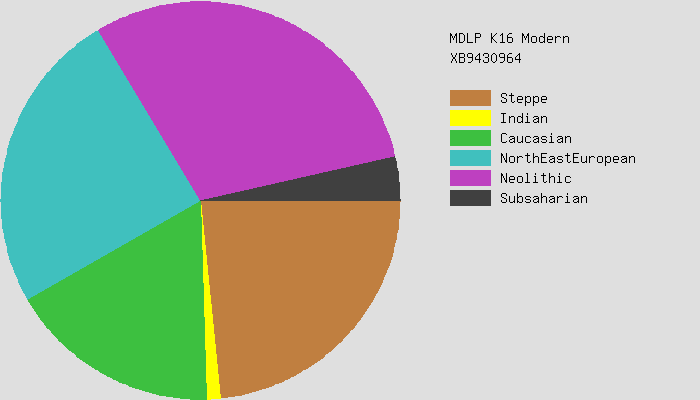
Using the MDLP K16 Modern calculator I got the following admixture,Admixture Results
30.04% Neolithic
24.72% NorthEastEuropean
23.27% Steppe
17.10% Caucasian
2.21% Subsaharian
1.30% Indian
0.51% Ancestor
0.49% NearEast
0.35% Amerindian
Neolithic - a component, modeled on genomes of first neolithic farmers of Anatolia (West Asia), these farmers from West Asia migrated to Europe during the Neolithic and carried this component with them.
NorthEastEuropean - a fancy moniker for a dominant type of ancestry in North-Eastern Europe based on older type of ancestry (WHG, west European Hunter-Gatherer), today this type of ancestry peaks in the Baltic region and Scandinavia.
Steppe - a component which was sourced from ancient genome of European Bronze Age pastoralists: it roughly approximates levels of ancient North Eurasian hunter-gatherers' heritage, which was subsequently shown to have an influence in later eastern hunter-gatherers and to have spread into Europe via an incursion of Steppe herders beginning ~4,500 years ago.
Caucasian - a major component of ancestry of modern inhabitants of Caucasus, Iran and northern Indian : it was derived from genomes of mesolithic Caucasian Hunter-gatherers: a major ancestral component linked to CHG was carried west and east by migrating herders from the Eurasian Steppe.
Subsaharian - a main component of ancestry seen in Yoruba, Mandenka and Luhya populations.
Indian - a component of ancestry harboured by populations of Indian subcontinent.
Ancestor - an archaic component, detected in modern African Pygmy populations (such as Mbuties and Biaka) and Khoisan hunter-gatherers.
NearEast - a component harboured and later carried by ancient populations of Near East, in our time it reaches the maximum among Bedoins and Saudi Arabians; the component seems to carry an excess of Eurasian Basal component relative to Neolithic component.
Amerindian - a component, which is modal (i.e has a peak) in various native American groups of North and South America, as well as in ancient DNA of Native Americans (Clovis, Kennewick man, etc).
Oracle Single Population Sharing (Population/Distance)
1 English (Kent) 2.86
2 French (WestFrance) 2.95
3 Scottish (Grampian) 3.12
4 Irish (Ulster) 3.17
5 Irish (Connacht) 3.18
6 Scottish (Highlands) 3.2
7 English (Cornwall) 3.26
8 Irish (Leinster) 3.32
9 Irish (Cork_Kerry) 3.35
10 English (England) 3.35
11 Scottish (Fife) 3.55
12 Shetlandic (Shetland_Islands) 3.77
13 Scottish (Dumfries_Galloway) 3.79
14 Scottish (Borders) 3.98
15 Irish (Munster) 4.01
16 French (France) 4.35
17 Welsh (Wales) 5.26
18 Dutch (Netherlands) 5.48
19 Orcadian (Orkney_Islands) 5.52
20 Scottish (Argyll_bute) 5.58
Oracle Mixed Mode Population Sharing (Primary/Secondary/Distance)
1 95.5% English (Kent) + 4.5% Yemeni (Yemen) @ 1.86
2 97.2% English (Kent) + 2.8% Siddi (Makran) @ 1.94
3 97.9% English (Kent) + 2.1% Bantu (SA_Herero) @ 1.99
4 81.2% English (Kent) + 18.8% Austrian (Austria) @ 2.01
5 98.1% English (Kent) + 1.9% Mende (Sierra_Leone) @ 2.02
6 98.2% English (Kent) + 1.8% Esan (Nigeria) @ 2.02
7 98.2% English (Kent) + 1.8% Yoruba (Nigeria) @ 2.03
8 98.1% English (Kent) + 1.9% Gambian (Gambia) @ 2.04
9 98.1% English (Kent) + 1.9% Mandenka (Gambia) @ 2.05
10 86.8% English (Kent) + 13.2% Italian (Friul) @ 2.05
11 96.1% English (Kent) + 3.9% Abhkasian (Abkhasia) @ 2.07
12 85.7% English (Kent) + 14.3% Swiss (Switzerland) @ 2.07
13 95.7% English (Kent) + 4.3% Iranian (Kerman) @ 2.08
14 97.8% English (Kent) + 2.2% Luhya (Kenya) @ 2.08
15 96% English (Kent) + 4% Georgians (Zugdidi) @ 2.08
16 89.2% English (Kent) + 10.8% Romanian (Romania) @ 2.08
17 95.4% English (Kent) + 4.6% Azerbaijani_Dagestan (Azerbaijan_Dagestan) @ 2.08
18 77.3% English (Kent) + 22.7% German (SouthGermany) @ 2.09
19 97.8% English (Kent) + 2.2% Luo (Kenya) @ 2.09
20 94.5% English (Kent) + 5.5% Greek (Azov) @ 2.09
Using the puntDNAL K12 Modern calculator [results are the same for the Ancient calculator] Anita got,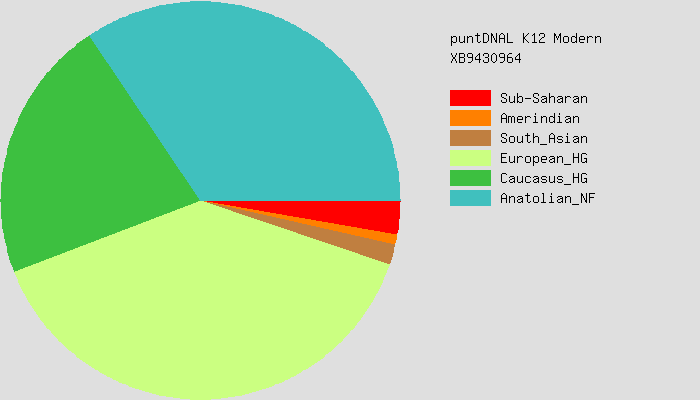
Admixture Results
39.03% European_HG
33.64% Anatolian_NF
21.27% Caucasus_HG
2.76% Sub-Saharan
1.47% South_Asian
0.96% Amerindian
0.35% Oceanian
0.27% South_African_HG
0.15% Beringian
0.12% Near_East
Oracle Single Population Sharing (Population/Distance)
1 Dutch_South 3.62
2 Utahn_European 5.06
3 Hungarian 5.35
4 German_South 5.46
5 Belgian 5.73
6 English_South 5.78
7 Croatian 6.33
8 Irish 6.8
9 Romanian 7.01
10 Dutch_North 7.12
11 German_North 7.61
12 Czech 8.36
13 Scottish_West 8.75
14 Norwegian 9.56
15 French 9.73
16 Swedish 11.45
17 Bulgarian 12.09
18 Icelandic 12.78
19 Italian_Bergamo 16.14
20 Spanish_Northeast 16.58
Oracle Mixed Mode Population Sharing (Primary/Secondary/Distance)
1 97% Dutch_South + 3% Mandinka @ 1.27
2 97% Dutch_South + 3% Esan @ 1.27
3 96.4% Dutch_South + 3.6% African_American @ 1.27
4 97.1% Dutch_South + 2.9% Bambaran @ 1.27
5 97.1% Dutch_South + 2.9% Yoruba @ 1.28
6 96.9% Dutch_South + 3.1% NE_Bantu @ 1.3
7 96.3% Dutch_South + 3.7% Maasai @ 1.73
8 95% Dutch_South + 5% Somali_Benadiri @ 2.15
9 95.9% Dutch_South + 4.1% Somali @ 2.18
10 95.8% Dutch_South + 4.2% Oromo @ 2.25
11 95.7% Dutch_South + 4.3% Ethiopian @ 2.42
12 91.7% English_South + 8.3% Somali_Benadiri @ 3.01
13 95.9% Dutch_South + 4.1% Algerian @ 3.02
14 93.1% Utahn_European + 6.9% Somali_Benadiri @ 3.03
15 96.8% Dutch_South + 3.2% Saharawi @ 3.1
16 96.5% Dutch_South + 3.5% Tunisian @ 3.14
17 96.6% Dutch_South + 3.4% Mozabite_Berber @ 3.14
18 96.4% Utahn_European + 3.6% NE_Bantu @ 3.19
19 98.1% Dutch_South + 1.9% Paniya @ 3.19
20 96.6% Utahn_European + 3.4% Esan @ 3.2
Using the Eurogene K36 calculator I got,
Admixture Results
.67% Central_African
5.11% Central_Euro
5.29% East_Central_Euro
6.21% Eastern_Euro
7.78% Fennoscandian
7.13% French
15.89% Iberian
3.69% Italian
17.98% North_Atlantic
3.03% North_Caucasian
18.61% North_Sea
.23% Pygmy
1.44% South_Central_Asian
3.84% Volga-Ural
1.17% West_African
1.92% West_Med
The latter calculator does not provide an Oracle analysis, so I ran my Eurogenes K36 results through a Map Creator. The higher the number the closer the matching. So, yeah, we're very much northwestern Europe in background.

I did find an Oracle for the Eurogenes K36 calculator on the yourDNAportal site. The results,
Closest Population DistancesMy True Ancestry
Population / Distance
IA_Britain_York_6DRIF18 0.7977587
EMA_Hinxton5_Anglosaxon 0.9379483
BA_Unetice_Poland_RISE150 0.9452259
MBA_Ireland_Rathlin 1.0198289
IA_Celtic_Britain_Hinxton1 1.0226182
BA_Unetice_Czechia_RISE577 1.0355462
SZ30_Celtic 1.0742165
I1767_Beaker_Britain 1.1248542
Population / Value
IA_Britain_York_6DRIF18 19.6
SZ30_Celtic 13
MBA_Ireland_Rathlin 10.8
IA_Celtic_Britain_Hinxton1 10
IA_Britain_York_6DRIF23 4.2
BA_Unetice_Poland_RISE150 3.2
IA_Hinxton4_Celtic_Roman 3.2
I1767_Beaker_Britain 2.4
I4070_Netherlands_BA 2.4
IA_Britain_York_6DRIF21 2
I3874_Beaker_South_France 1.6
LNBA_Urnfield_Germany_I0099 1.4
Bell_Beaker_Germany_I0113 1.2
DA111_Hallstatt-Bylany|_800BC 1.2
Baiuvarii_Germanic_AED_249 1
Baiuvarii_Germanic_STR_316 1
I5385_Scotland_Bell_Beaker 0.8
IA_Britain_York_6DRIF3 0.8
MBA_Germany__RISE471 0.8
Visigoth_I12032 0.8
BA_Afanasievo_RISE509 0.6
BA_Portugal_MonteGato_104 0.6
CWC_Germany_I0103 0.6
IA_Wielbark_Kow_22_PL 0.6
Visigoth_Iberian_I12034 [Visigoth 80-85% Iberian] 0.6
BA_Andronovo_RISE500 0.4
BA_Karasuk_RISE499 0.4
BA_Mezhovskaya_RISE523 0.4
BA_Mezhovskaya_RISE525 0.4
BA_Portugal_Vale_Ouro 0.4
BA_Unetice_Germany_I0117 0.4
Bell_Beaker_Germany_I0059 0.4
CHL_Yamnaya_Samara_I0443 0.4
CWC_Estonia_Ardu1_MA968 0.4
CWC_Estonia_Sope_MA826 0.4
CWC_Sweden_RISE98 0.4
EMA_Anglosaxon_NO3423 0.4
EMA_Hinxton2_Anglosaxon 0.4
I1767_EarlyBronze_Age_Briton 0.4
IA_Britain_York_6DRIF22 0.4
BA_Afanasievo_RISE507 0.2
BA_Armenia_RISE407 0.2
BA_Karasuk_RISE492 0.2
BA_Karasuk_RISE502 0.2
BA_Portugal_TorreVelha_3831 0.2
BA_Sintashta_RISE395 0.2
BA_Srubnaya_I0232 0.2
BA_Srubnaya_I0234 0.2
BA_Srubnaya_I0354_outlier 0.2
BA_Sweden__RISE175 0.2
BA_Unetice_Germany_I0164 0.2
Baiuvarii_Germanic_STR_241 0.2
Baiuvarii_Germanic_STR_248 0.2
Baiuvarii_Germanic_STR_355 0.2
Baiuvarii_Germanic_STR_480 0.2
Bell_Beaker_Germany_RISE563_ 0.2
CHG_Kotias 0.2
CHL_Iberia_I1277 0.2
CHL_Yamnaya_Samara_I0441 0.2
CL151_Longobard 0.2
CL57_north-Italian 0.2
CL83_Celto-Longobard 0.2
CL84_Longobard 0.2
CL93_Longobard 0.2
CWC_Germany_I0104 0.2
DA230_Karluk 0.2
EBA_Poland_RISE431 0.2
EBA_Russia_RISE555 0.2
EMA_Alpine_STR_328 0.2
EMA_Hinxton5_Anglosaxon 0.2
I10892_Catalonia_medieval 0.2
I1388_Beaker_South_France 0.2
I2462_Bronze_Age_England_Kent 0.2
I3496_Iberian_Catalonia_200BCE 0.2
IA_Altai_RISE602 0.2
IA_Britain_York_3DRIF16 0.2
IA_EastKazachstan_Is2 0.2
IA_EastKazachstan_Ze6 0.2
IA_LevantEgypt_Gladiator_3DRIF26 0.2
IA_Sarmatian_PR9_I0574_Pokrovka 0.2
IA_Scythian_I0247a 0.2
LN_Portugal_Monte_Canelas_1 0.2
MBA_ATP9_Iberia 0.2
MN_Iberia_I0406 0.2
N_Germany_I0795 0.2
SZ15_Longobard 0.2
SZ38_Longobard 0.2
SZ42_Longobard 0.2
The below is from MyTrueAncestry and tries to show your relationship to ancient peoples and empires. Anita's closest Ancient populations ...
Celt + Frank (4.621)This makes sense as the wife's mother-line is strongly Irish and her father-line is strongly English.
Saxon + Frank (4.886)
Saxon (6.845)
Celt (7.355)
Frank (7.504)
| The Celts
Tribes included the Gauls, Helvetii, Scordisci, Serdi, Boli and Iceni among others. Wherever Celts settled, they spoke the same language and maintained the same artistic traditions. Celtic warriors were known for long hair and imposing physique. By serving as mercenaries for Carthage against Rome, the Celts gained a reputation for being fierce warriors and skilled horsemen who fielded chariots into battle. Celts used musical instruments called carnyces which were used to frighten the enemy before combat. Greek art depicts their distinctive long shields and long swords. Among insular Celts, women could take a warrior role - Boudica was the queen of the Iceni tribe who formed a rebellion against Roman occupation of Britain. Celtic art can combine geometric decoration with figurative subjects in a extremely stylised manner. See also my page on Celtic Origins. |
Your closest Archaeogenetic matches, ordered by genetic distance:
1. Young Merovingian Noble (605 AD) (4.565)
2. Nordic Lombard (590 AD) (5.068)
3. Scotland Late Bronze Age (900 BC) (5.457)
4. Bell Beaker England (2100 BC) (5.504)
5. Bell Beaker England (2150 BC) (5.964)
6. 1815-1789 BC Thames (1800 BC) (6.239)
7. Viking Gaelic Mix Iceland (1000 AD) (6.334)
8. Nordic Lombard (590 AD) (6.372)
9. Celtic Gladiator York (250 AD) (6.401)
10. Bronze Age Orkney Islands (1750 BC) (6.429)
11. Late Medieval Gotlander (1600 AD) (6.678)
12. Bronze Age Celt England (1000 BC) (6.794)
13. Celtic Briton Gladiator York (250 AD) (6.799)
14. Saxon Hinxton (720 AD) (6.845)
15. Medieval Netherlands Plague II (1360 AD) (7.069)
16. Germanic Lombard (590 AD) (7.167)
17. 1815-1789 BC Northern England (1750 BC) (7.244)
18. Colonial American Pennsylvania (1700 AD) (7.344)
19. Gaelic Settler Viking Iceland (935 AD) (7.355)
20. Frankish / Hungary (590 AD) (7.504)
21. Bell Beaker Cambridge (2075 BC) (7.681)
22. Frankish / Hungary (590 AD) (7.701)
23. Bell Beaker England (2150 BC) (8.016)
24. Celtic Briton (1 AD) (8.068)
25. Visigoth Germanic Girona (550 AD) (8.075)
26. Pict (670 AD) (8.158)
27. Bell Beaker Oxford (2150 BC) (8.164)
28. Bronze Age Scottish Islands (2350 BC) (8.319)
29. Medieval Norway Sankt Nikolai B (1349 AD) (8.342)
30. Nordic-Celtic Gladiator York (250 AD) (8.39)
31. Bell Beaker Scotland (2100 BC) (8.47)
32. Nordic Lombard / Winnili (590 AD) (8.478)
33. Alemannic Bavaria (500 AD) (8.575)
34. Viking Gaelic Mix Iceland (935 AD) (8.61)
35. Celtic Briton (70 BC) (8.614)
36. Nordic Lombard (590 AD) (8.712)
37. Viking Sweden (1100 AD) (8.779)
38. Viking Sweden (1100 AD) (8.869)
39. Bell Beaker Scotland (2145 BC) (8.903)
40. Germanic Lombard (590 AD) (8.905)
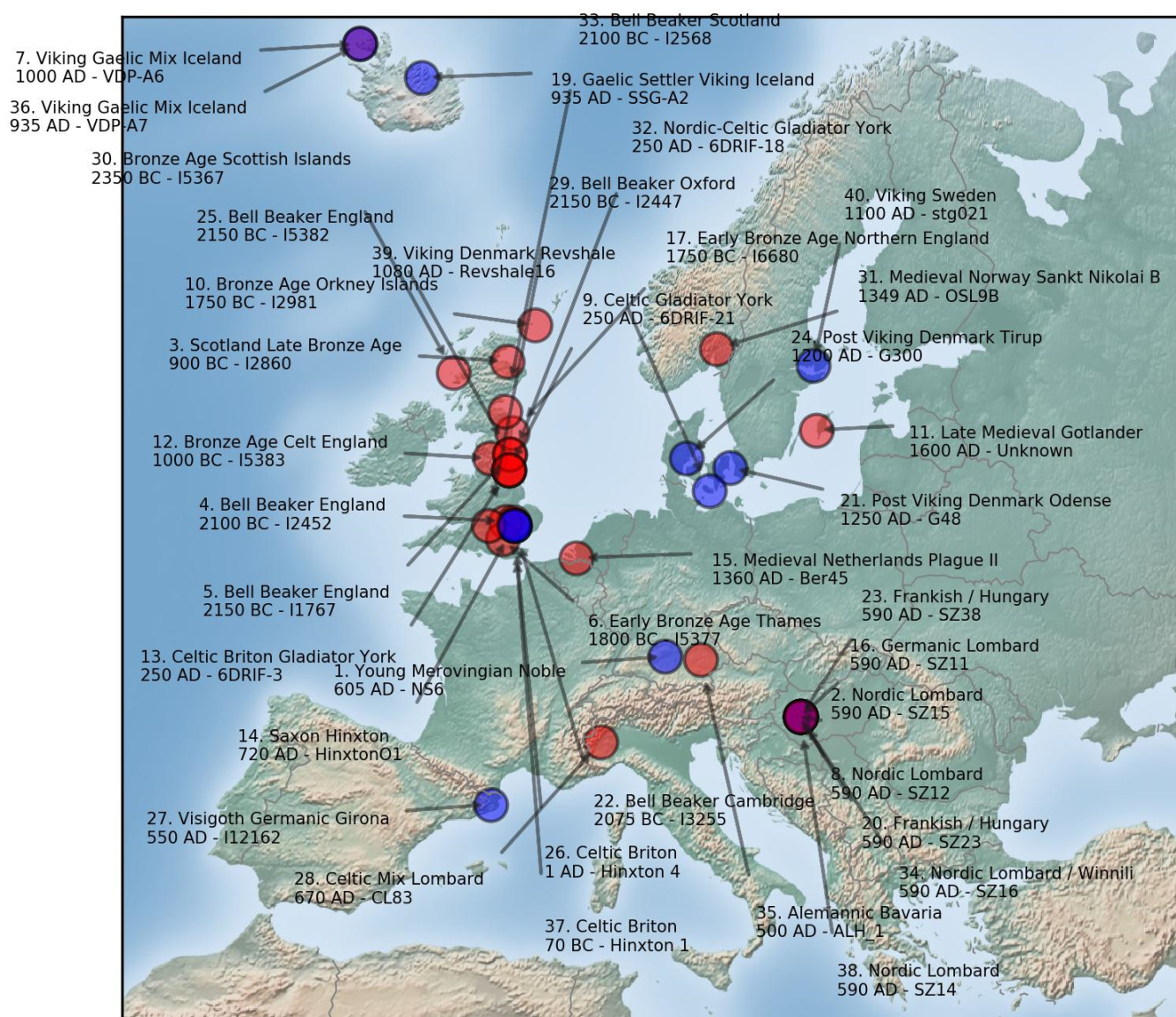
Anita's closest Archaeogenetic matches, in timeline format:
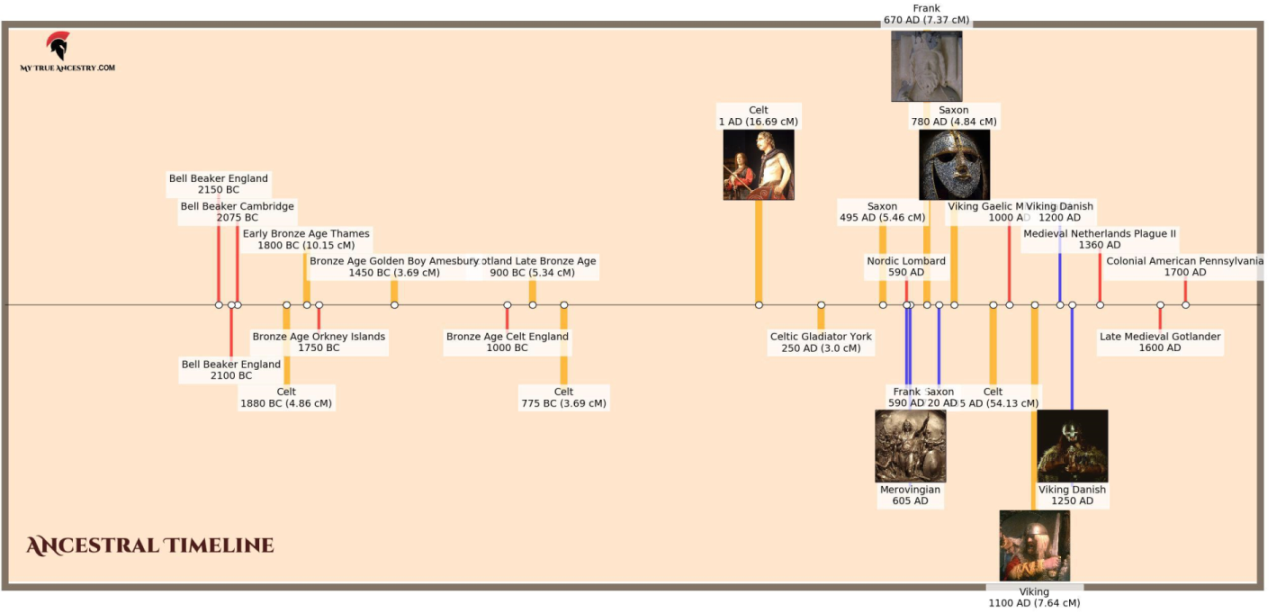
Maps of the above:
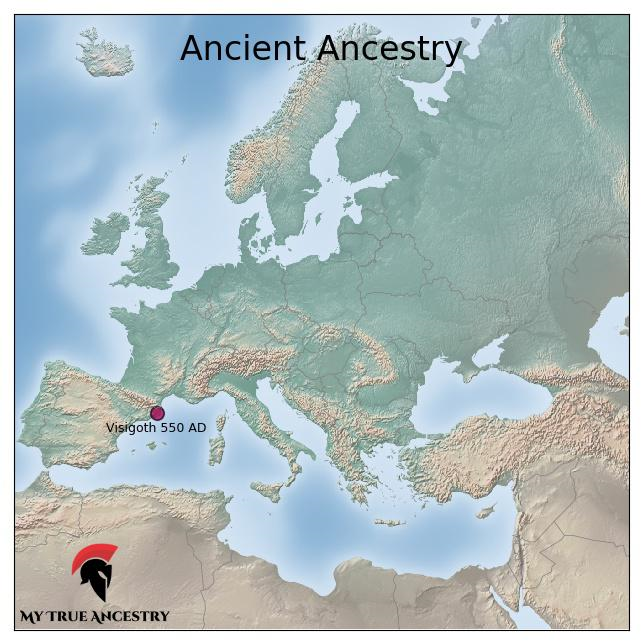
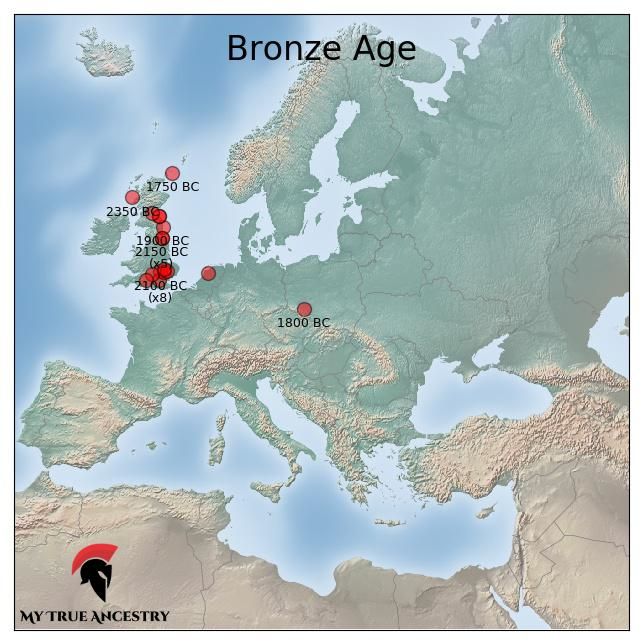
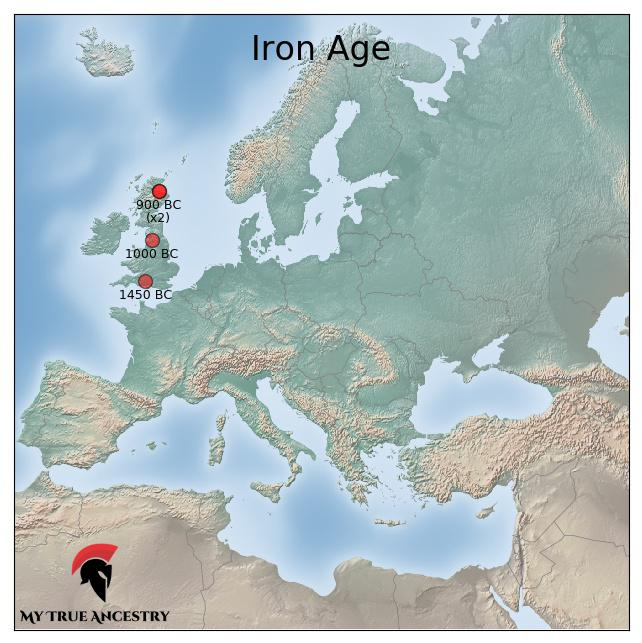
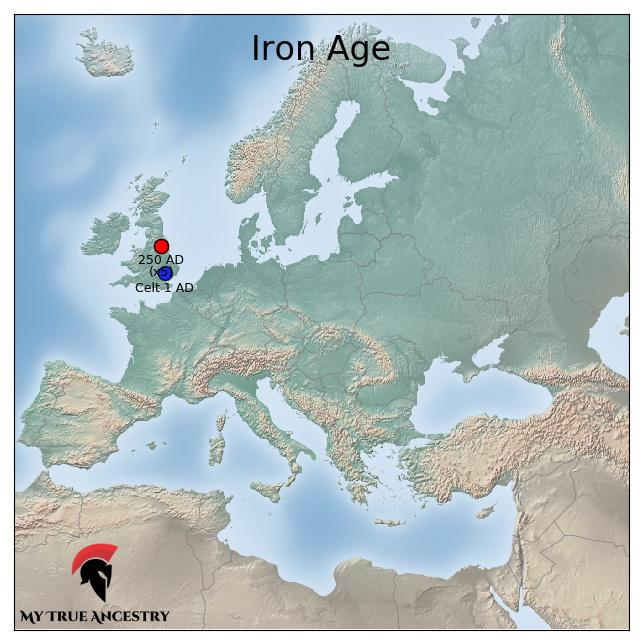
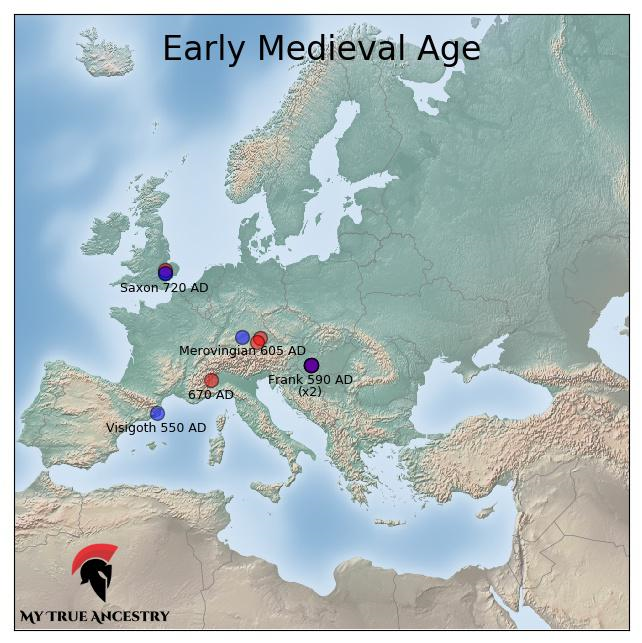
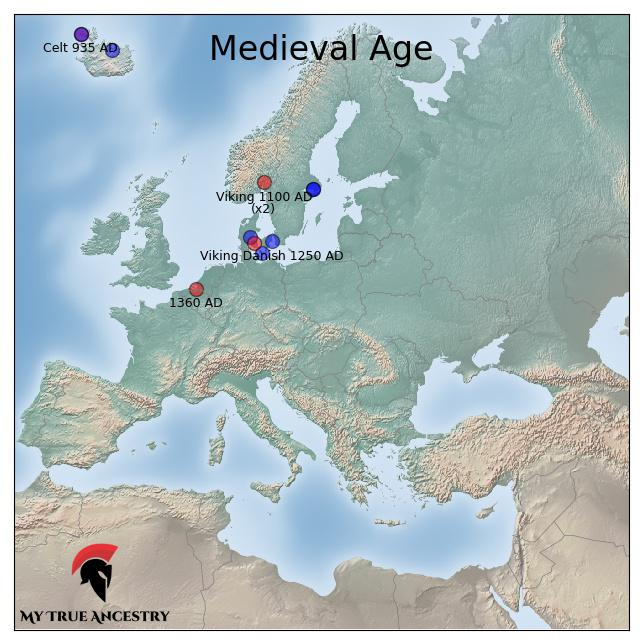
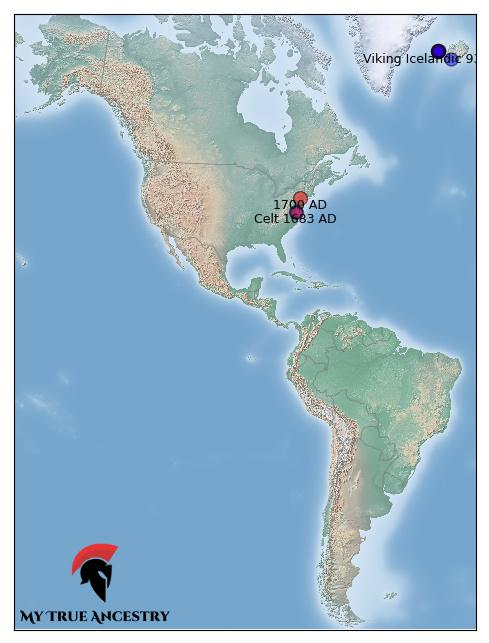
Ancient relatives with whom Anita shares identified DNA segments:
Gaelic Settler Viking Iceland (935 AD)
1815-1789 BC Thames (1800 BC)
Viking Sweden (1100 AD)
Saxon Oakington (495 AD) [about 70 miles north of London]
Ireland Copper Age (1880 BC)
Halstatt Celt (775 BC)
Frankish-Gaul / Lombardy Italy (670 AD)
Celtic Gladiator York (250 AD)
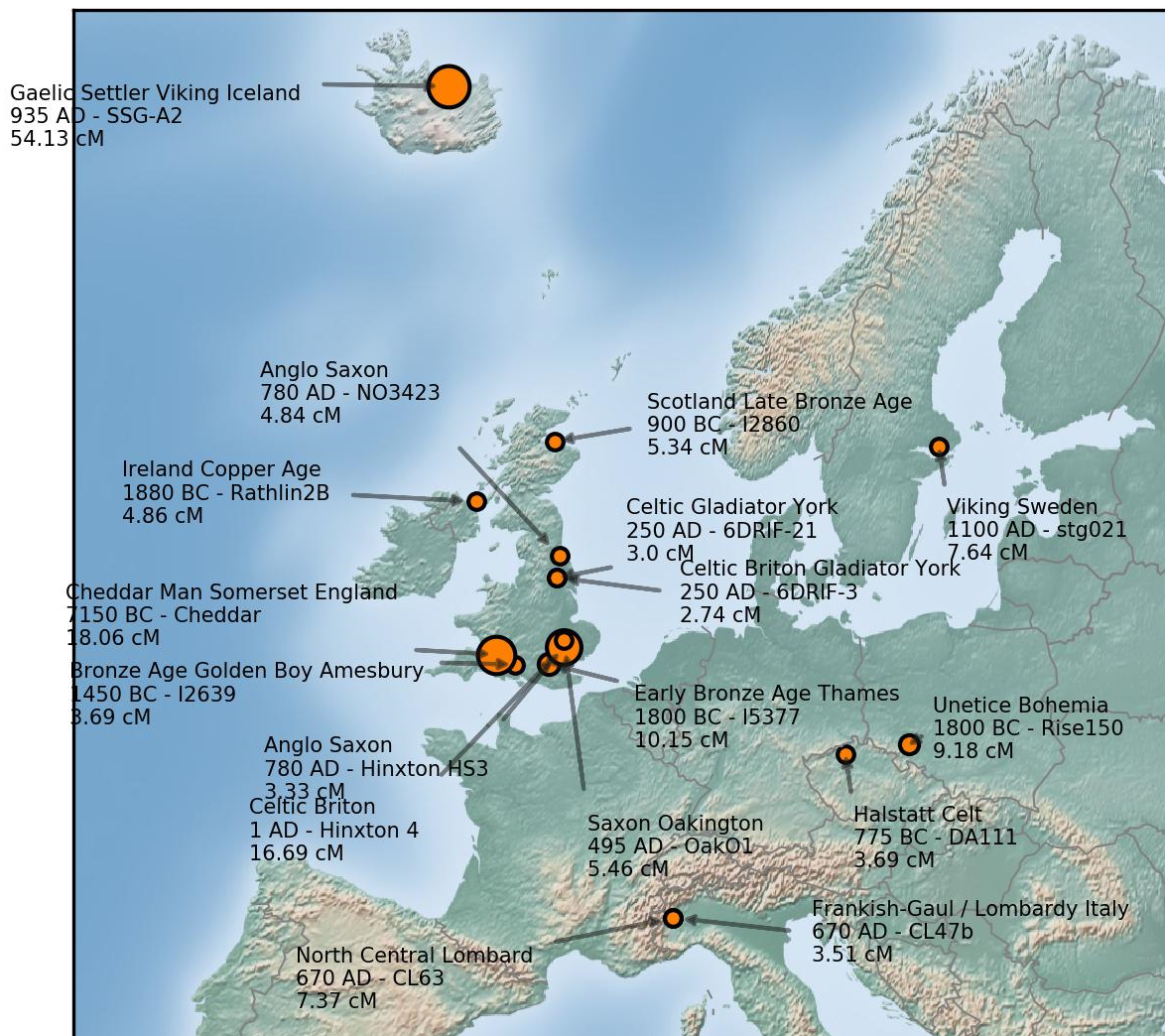
Anita's closest genetic modern populations...
1. North_Dutch (4.993)
2. Danish (5.034)
3. North_German (5.428)
4. Southeast_English (5.801)
5. Irish (6.020)
6. West_Scottish (6.096)
7. Orcadian (6.340)
8. Southwest_English (6.494)
A new feature predicts the Y-DNA Distribution of all male samples that match my autosomal DNA kit. The results are,
67.0% R1bI would have predicted that Anita's father-line, Montagues who emigrated from near Windsor, England, would be R1b. Her mother-line is complicated, being comprised of just about all the mtDNA types ever living in Europe, H, I, J, K, N, T, U and W. That underscores the observation that when invasions occur the resident males get killed and the resident females get married.
13.6% R1a
11.3% I2
03.4% I1
02.27% J
01.13 E
01.13% N